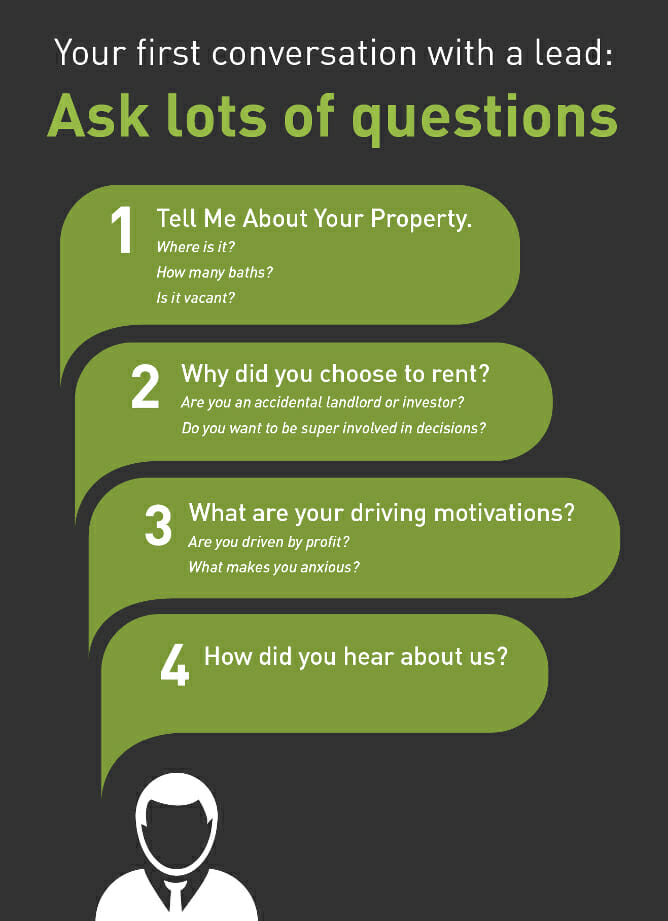Never judge a book by its cover, we’re told. But whether we admit it or not, we’re always judging people, and they’re sizing us up too. First impressions matter, and sometimes they last forever. Your website is the first opportunity to make a positive impression on a property owner. When you plan and manage your lead follow-up communications effectively, you reinforce that critical first impression.
In our previous post, we covered how to distribute your sales leads among your sales agents. In this fourth article in our five-part series on making the most of online sales leads, we discuss the basics of a marketing communications strategy to nurture property management leads and convert them into clients.
After you’ve identified a lead, Job One is convincing those leads to entrust you with their precious properties. In property management, coming across professionally helps build an owner’s confidence in your business, and it vaults you ahead of competitors who don’t invest the time to hone their communications skills.
Here we’ll focus on the building blocks of communicating with leads, in particular your:
- Website’s content
- Emails
- Direct mailings (using the U.S. Postal Service)
- In-person and phone conversations
Even Small Website Improvements Make a Big Impression
For owners, your website is often their first touch point with you and your business, so make sure your site stands out. Thoughtful, compelling content on your site—engaging writing, and well-lit, nicely composed photos and videos—will set your company apart from those who put little creative thought into their websites.
Jeff Erdman of property management company Lakeshore Corporation in Kirkland, WA says, “The prospect sees who [you] are, what sets [you] apart and what [you] can offer from the initial contact through the process to being a client.”
Add Punch & Persuasiveness to Your Email Communications
In the second part of this series, we discussed how quickly you should respond to online leads, via phone and email. Fortunately, email is one of the fastest, easiest, and least expensive ways to follow up with and nurture leads. If you spend just one hour every Monday morning planning your email communications, it can pay huge dividends.
Here are three email marketing basics to get you started:
- Keep your emails short and to the point, choose eye-catching subject lines, and personalize your messages.
- Automate most of your emails with a tool like Constant Contact, which offers some tips to help you inspire people to open your emails.
- Write professionally. Think about working with a copywriter to help you nail down the language. An experienced writer will make you sound, in writing, like the true pro you are and reflect favorably on your brand.
As with any sales follow-up plan, you’ll have to be persistent (but not pushy) in reaching out to and replying to leads. No doubt, this takes time, but instead of trying to do it all at once, break your lead follow-up efforts into smaller chunks and spend, for example, 20 minutes a day on them.
Never Underestimate the Power of Well-Crafted Direct Mailings
Direct mail—postcards and sales letters sent via “snail mail”—can still be very effective, even in today’s digital world. A frequent objection to direct mail is that it’s too expensive. And it’s not easy to measure attribution (was it your mailing that prompted the prospect to contact you?) or effectiveness (did the mailing get your message across?).
Without the digital trail and metrics that email programs provide, it’s hard, and in many cases, impossible, to tell if prospects are taking the time to read your mailings, or if the mailings have made your intended impact on them. In fact, the only way you’ll know is when a lead contacts you directly and tells you so, or enters a tracking code from your mailing into a form on your website.
If direct mail sounds like too much of an adventure for you or would put a strain your budget, focus more on your email communications. Less expensive than direct mail, email offers many simple ways to track how well your messages perform and the return on your investments in time, effort, and money.
Have Personal & Memorable Conversations with Owners
Property owners are deluged with emails every day, and they don’t have time to read every one. Even when a lead does read your email or letter, they might not yet be in the market for property management services. (But hopefully your email made the right impression and they remember you when they are ready.)
When you win the opportunity to talk with a lead, whether over the phone or, better yet, in person, your odds of closing a deal escalate—as long as you know the proper way to talk with a lead.
So, what should you talk about? First, let the property owner start the conversation by asking you questions. Next, follow up with questions of your own. Jordan Muela, CEO of LeadSimple, a company that makes property management lead tracking software, suggests “starting broad and then narrowing down as you follow the trail of feedback.”
For example, begin by inquiring about the property, asking questions such as: “How many bedrooms does it have? Does it have a modern kitchen and bathroom? Is it vacant? For how long, and why?”
Next, turn your attention to the owner. Property management is as much about managing people as it is buildings and units. Find out if the owner is a good fit for your business. What level of service do they expect? What motivates and drives them? Why rent out the property, instead of sell it?
And finally, a good closing question is: “How did you hear about us?” You may even get answers to your questions about the effectiveness of your direct mailings.
Ultimately, Muela says, “The more people talk, the more comfortable they get and the more invested they become in the relationship and the idea of working with you.” And the more you learn from a customer, the more business and people intelligence you gain, which will help you reach your sales goals and grow your company.
Communicating effectively with sales leads differentiates your property management business from your competitors’. Attract owners and make a strong first impression by fine-tuning your website content, and nurture them by sending emails or direct mailings with relevant, timely, and personalized information.
But don’t forget the power of following up with leads in-person (or on the phone). A conversation with a property owner can accelerate the beginning of a new client relationship. If you impress owners by taking time to understand what makes them tick, they may become your newest clients today — or six months down the road.
Even if your leads don’t become clients right away, they may refer you to a colleague, family member, next-door neighbor, or the coach of your kids’ soccer team. When it comes to identifying new clients and building your business, no other endorsement beats a word-of-mouth referral.
Next in our series: How to Calculate Your Return on Investment
Read more on Growth


